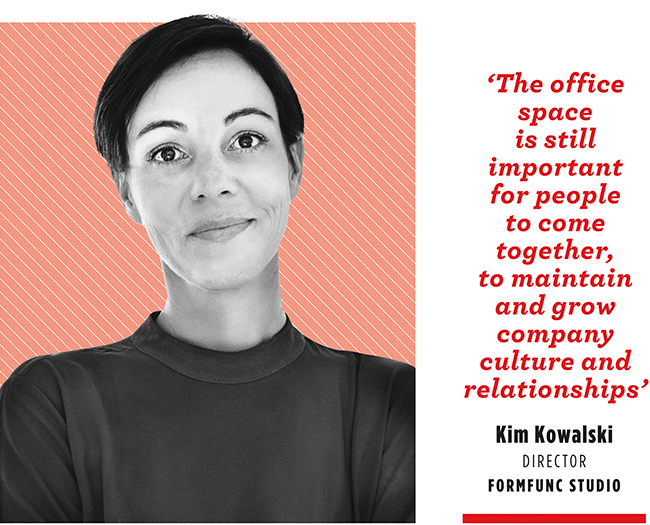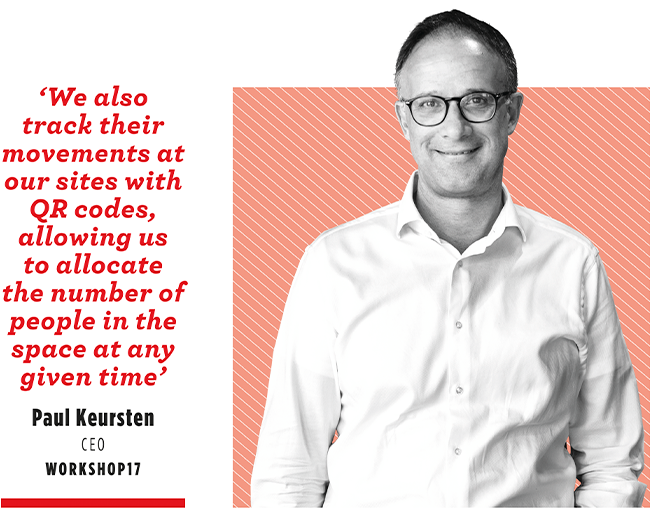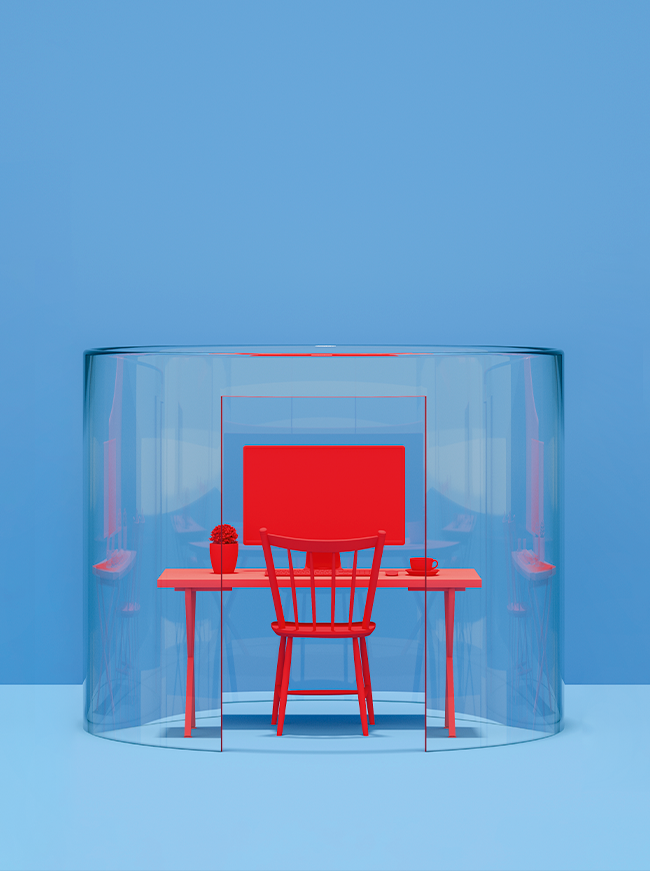If working from home gave us the freedom of flexible hours, tracksuits and time with family and furballs, it also brought endless interruptions, backache from working at dining or kitchen tables, and the stress of constant technological connectivity with employers, clients and colleagues – plus the added concern about SA’s uncertain power supply. Small wonder why, while studies and worker surveys indicate our productivity increased, most people would not choose to work at home 100% of the time. The fact is, most successful companies know the power of in-person collaboration, connection, stimulation and teamwork in shaping a healthy corporate culture – and so do their employees. ‘Corporates may be downsizing, but the office space is still important for people to come together, to maintain and grow company culture and relationships face to face – something that is impossible virtually,’ says Kim Kowalski, director of Formfunc Studio, which is dealer-partner to Humanscale. Karin Lategan, director at Formist Signature Spaces, Cape Town, believes working from home ‘will remain a permanent option; we were heading there even before COVID. But humans are social beings and feel isolated – coming into the office for at least some of the week, there’s a shared sense of life; that we’re not alone in this. That’s a win for employees and for employers, as boosting mental well-being promotes vibrancy and creativity. We just need to make it happen safely’.
With this in mind, the office of the future will shift away from ‘a place to sit and work’ to a place to communicate, collaborate and build company culture, says Estelle Meiring, director of Paragon Group. ‘I see the office space housing a lot less traditional workspace and a lot more couches and social seating, even if these seats each have their own fold-open writing desks,’ says Meiring.

According to Paul Keursten, CEO of Workshop17 workspace solutions, the office ‘will no longer be a specific space in one building, but a combination of physical spaces accompanied by virtual office resources that enable online meetings, planning and collaboration. We’re hearing from corporates that they are open to limiting their traditional office space environments, in some cases reducing their office premises by more than 50%’. He detects an appetite for a ‘third space’ – a flexible office concept relatively close to employees’ homes to avoid long commutes, that is ergonomic and functional, and ‘offers a great atmosphere in which their staff can be creative and effective, as well as interact and be inspired by others’.
Lategan cautions, however, that ‘this is an entirely new area. Everything we’re saying is theoretical as no one’s tested it properly yet. But pre-COVID, big corporate clients like PwC were already aligned with post-COVID thinking in their emphasis on flexibility, smart technology and sustainability. Our personal opinion, after lots of research and monitoring what’s already happening internationally, is that the office is changing completely. The need for office real-estate is much smaller, and the traditional office layout is gone – the office split into single-use areas with set collaborative and breakout and training spaces is gone’.
For now and the foreseeable future – given the mutations or other contagions we’re all too aware can arise – entirely new interior design principles rule. In fresh builds, focus will be on antimicrobial building products selected in line with sanitation and environmental concerns. ‘Experts are saying in 10 to 15 years we’ll all drive electric cars, and in the same way, offices will be cleaned by UV light after hours,’ says Lategan. In September, St Pancras International in London, the terminus for Eurostar links, became the first station in the world to employ UV light-tech robots. They use UV to sweep large areas without the need for chemical disinfectant, killing nearly 100% of bacteria and viruses – including the coronavirus – on surfaces and in the surrounding air in minutes. ‘At present it’s hugely expensive technology, but costs will come down as demand grows,’ says Lategan. ‘Now is a fantastic time to be in product development.’

In the meantime, new office design principles are already coming into play in interior-space planning and conceptualisation as companies adjust to the new environment, repurposing and finding creative ways to alter existing buildings to perform new functions, offering flexibility, according to Meiring.
‘Companies and employees will need to be flexible and agile,’ adds Kowalski. And, given the need for social distancing and sanitation, Lategan believes all spaces will be hybrid. ‘Ideally everything should be able to flat-packed and reassembled,’ she says. The need for reduced employee numbers in the office won’t change. ‘For an organisation with, say, 700 staff, it’s estimated a maximum of 20% to 30% will be in the office at any one time. Most corporates are already there.’ There will no longer be designated individual spaces (offices, cubicles). Instead there will be what Lategan refers to as ‘touch-down spaces’, which you’ll book or be allocated for a pocket of time each day. ‘When you finish, technology will notify cleaning teams to sanitise the space for the next person.’ Keursten says his company has ‘added items such as disposable paperwork mats to protect surfaces’. Each person is screened on entering the workspace, ‘and we also track their movements at our sites with QR codes, allowing us to allocate the number of people in the space at any given time’. Meiring notes ‘a feeling that people want to “own” a portion of workspace and be in charge of its hygiene. It might mean, for example, that every employee owns their own personal desk surface, something that can be clipped in and out and remain for exclusive use by one person’.
Offices will have separate entrances and exits, and – where possible – corridors and stairs will be one-way or, if wide enough, divided and marked to keep people moving with minimised face-to-face contact. Other measures include the lifts. Where there is more than one, they will be adjusted to serve specific floors. In lower buildings, people will be encouraged to take stairs. Where there are two staircases, one will be for upward flow, one for downward, or wide staircases will be divided to achieve this.

No-touch tech will become commonplace. Facial or smartphone recognition will control access into the building and various areas within it according to programmed security permissions. No-touch wave tech will operate everything from boom gates to lift buttons and bathroom taps, and toilet stalls will have springs and latches with push-releases that respond to an elbow nudge. Work pods/partitions may be provided by high-end firms, where each worker is enclosed in their own small work area with a desk and computer. Most firms will have partitions, usually in perspex – easily cleaned and sanitised. ‘We make ours mobile, rather than part of a desk, for greater flexibility,’ says Lategan.
Air quality will obviously become an important issue. ‘We focus the biggest part of post-COVID office refurb budgets on air control, quality and ventilation,’ says Lategan. The concept of well-being in the workplace has been gaining traction for years, and access to light and air is key for physical and mental health. With all these changes, prominent, visible communication of COVID-19 safety features are crucial in the new office. ‘Employees and clients want to see what the organisation is doing for their safety, in sanitising stations and signage,’ says Lategan.
If your office doesn’t yet have these features, be patient. ‘Most facilities-management teams are still just trying to cope with current demands in a squeezed economy, and ensure basic hygiene and safety,’ she says. ‘And most workers, desperate to hang on to their jobs, are keeping quiet and trying to cope. But if we can just get through this, we can move on to a brave new office future.’








